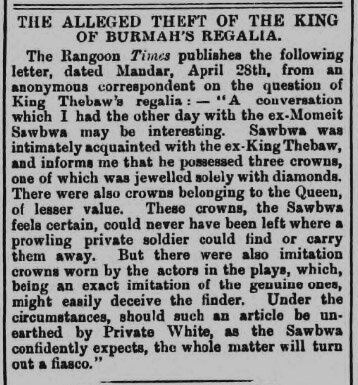Dearest Emily,
I trust you have been deep in discoveries of late, your last letter spoke of such wondrous archaeological expeditions throughout our fascinating little island. I cannot wait to hear all about your adventures very soon. As for me, my immersion into the collections I maintain at the British Library continues. This is perhaps my most astounding revelation to date, I can’t wait to share it with you.
The rollercoaster race for Royalty in 19th century Burma is well documented in British Library collections. As well as printed biographies in English and Burmese language, the India Office records contain a mass of correspondence, reports and private papers pertaining to British operations in Burma, particularly regarding the reign and dethronement of King Thibaw, Burma’s last king.
Some of these tumultuous tales are lesser known than others. An album of Photographic illustrations chronologically recounts a remarkable journey through the recently annexed country by a British expeditionary force. Within this document is an intriguing tale of daring escapes, hidden identities, attempted revolution and a long-forgotten prince.
King Thibaw ascended the Burmese throne aged just 19. His rise to power was shrouded in brutality, as was typical of Burmese royal transitions in the age. British soldiers transmitted tales of convicts trampled to death by elephants, the beheading of unsatisfactory palace staff for minuscule mistakes and the massacre of Thibaw’s entire Royal lineage, a feat most likely orchestrated by the Queen Mother and Thibaw’s wife and half-sister, Suphayalat, to secure his place on the throne.
The princes and princesses of Burma had been summoned to Mandalay Palace, to attend the death bed of King Mindon. As each arrived, they were cruelly executed and buried in the palace grounds. Over 70 family members and potential rivals were eradicated.
The Photographic illustrations of the Mandalay & Upper Burma Expeditionary Force, taken and compiled by cavalry officer Robert Blackall Graham between 1886-7, told of two princes who survived the massacre. Prince Moung Peng, grandson of King Mindon and his older brother were rescued from the plot by Phongyi’s.
A Phongyi was a Buddhist Monk. They dressed in an orange robe wrapped around the body, usually thrown over the left shoulder. Their heads were shaven and always uncovered and they carried a palm-leaf fan for protection from the sun. A Phongyi lived on charity, taught the young and lived a life of devotion, in order to be absorbed into the divine essence.
The princes were spirited from danger and hidden in temples amongst the Phongyi’s, disguised as priests for many years until the British suppression of Mandalay meant the immediate danger to their lives had subsided. They resided in Ava for a while, but after mistreatment by his older brother, Moung Peng sought refuge with his former protectors in Mandalay.
A wise astrologer prophesied that Moung Peng would one day be returned to the Burmese throne. In December of 1886, the prophecy was used as justification to rebel against the invading British forces and Moung Peng became the focus of a botched coup. A plot was arranged to set four fires in Mandalay and draw the British forces into a trap. One of the fires was mistakenly lit before the arranged date, revealing the entire plan to the occupying armies.
The instigators of the plot, amongst them two senior Burman monks and several priests, were transported for life to the penal colonies in the Andaman’s where confinement was the least of the punishments they could expect. Torture, starvation, medical testing and murder were amongst the brutal regimes of these remote British fortresses.
Prince Moung Peng, aged just 13, was sent to Dr Marks School, a Christian mission in Rangoon. The British aimed to condition the prince in a secure environment and remove any threat he might pose to their control in Burma. His eventual fate is unclear, but he never fulfilled the prophecy to become the King of Burma.
Craig Campbell
Curatorial Support Officer
India Office Records
The British Library
Further Reading:
Photo 996 - Photographic illustrations, with descriptions of Mandalay & Upper Burmah Expeditionary Force, 1886-87. By a cavalry officer. Photographer(s): Graham, Robert Blackall
Photo 996 (56) - Prince Moung Peng [Mandalay]. Photographer: Graham, Robert Blackall - 1887
Portrait of Moung Peng, a grandson of King Mindon Min, here seen seated in a royal carriage. After the British occupation of Upper Burma, he became part of a conspiracy to regain power and oust the British. He was later sent to study under Dr Marks at Rangoon. At the time of the taking of this photograph he was aged thirteen.
Englishman’s Overland Mail; 01 February 1887; pp 9-10 – Special Telegram from our correspondents: Rangoona Jan 28
Available on Find My Past https://www.findmypast.co.uk/
(While within British Library you have access to certain records through a partnership with Findmypast)
Mss Eur F595/8/16 - Confidential India Office Note on the relations between the Government of India and Upper Burma during the present King's Reign [Thibaw Min, King of Burma 1878-1885]: India Office Records and Private Papers
Or 14963 - [Scenes of British deposition of King Thibaw]: Oriental Manuscripts
Mss Eur E290 - Papers of Col Sir Edward Sladen, Madras Army 1849, British Burma Commission 1856-86: India Office Records and Private Papers
V 16959; X.800/6024 - Deposed King Thibaw of Burma, in India, 1885-1916 / W.S. Desai. Bombay : Bharatiya Vidya Bhavan, 1967.
DRT ELD.DS.450930 - The king in exile : the fall of the royal family of Burma / Sudha Shah. New Delhi : HarperCollins Publishers India, a joint venture with the India Today Group, 2012.
09059.aa.45; T 2865; X7/1536 - They reigned in Mandalay / E.C.V. Foucar. London : Dennis Dobson, 1946.









